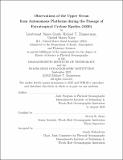| dc.contributor.advisor | Jayne, Steven R. | |
| dc.contributor.author | Zimmerman, Michael T. | |
| dc.date.accessioned | 2023-11-30T21:43:17Z | |
| dc.date.available | 2023-11-30T21:43:17Z | |
| dc.date.issued | 2023-09 | |
| dc.date.submitted | 2023-09-28T19:00:42.961Z | |
| dc.identifier.uri | https://hdl.handle.net/1721.1/153102 | |
| dc.description.abstract | Hurricane Epsilon (2020) was a late-season, category-3 tropical cyclone that underwent extratropical transition and became Extratropical Cyclone Epsilon on 26 October. The upper ocean response to the passage of the storm was observed by three types of autonomous platforms: the eXpendable Spar buoy, the Air-Launched Autonomous Micro Observer profiling float, and two Seagliders. Taken together, this array enabled the rare collection of contemporaneous observations of the upper ocean, air-sea interface, and atmospheric boundary layer before, during, and after the passage of the storm. The evidence presented highlights how Extratropical Cyclone Epsilon broke down the residual North Atlantic summer stratification regime and accelerated the shift to the period of prolonged ocean cooling associated with winter. The significance of the synergistic capabilities of the array is two-fold: 1) comparing observations of the same parameters, taken from different platforms, enables a comprehensive approach to better understanding how storm-induced momentum, sensible heat, and moisture fluxes input kinetic and near-inertial energy into the ocean and thereby alter upper ocean structure; and 2) future, targeted deployments of similarly capable observational arrays will reduce the uncertainty of tropical and extratropical cyclone intensity forecasts by facilitating the assimilation of real-time subsurface ocean data into coupled numerical prediction models. | |
| dc.publisher | Massachusetts Institute of Technology | |
| dc.rights | In Copyright - Educational Use Permitted | |
| dc.rights | Copyright retained by author(s) | |
| dc.rights.uri | https://rightsstatements.org/page/InC-EDU/1.0/ | |
| dc.title | Observations of the Upper Ocean from Autonomous Platforms during the Passage of Extratropical Cyclone Epsilon (2020) | |
| dc.type | Thesis | |
| dc.description.degree | S.M. | |
| dc.contributor.department | Massachusetts Institute of Technology. Department of Earth, Atmospheric, and Planetary Sciences | |
| mit.thesis.degree | Master | |
| thesis.degree.name | Master of Science in Physical Oceanography | |
